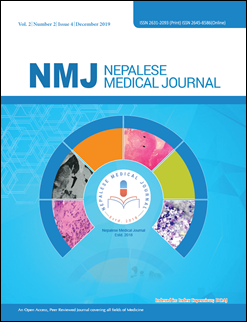Use of Low Dose Pregabalin for Attenuation of Hemodynamic Response to Laryngoscopy and Intubation in Treated Hypertensive Patients
DOI:
https://doi.org/10.3126/nmj.v2i2.25715Keywords:
Induction; Premedication; Pressure responseAbstract
Introduction: Laryngoscopy and tracheal intubation are two powerful noxious stimuli that can be potentially deleterious especially in hypertensive patients. This study evaluated the efficacy of low dose oral pregabalin used as a premedication for attenuation of this marked sympathetic response of airway instrumentation.
Materials and Methods: This was a double-blind randomised study done at a tertiary level referral hospital. The trial was registered as UMIN-000037103 (https://www.umin.ac.jp/ctr/). Patients were randomly assigned into two groups. Placebo arm received multivitamin capsule and treatment arm received Cap. Pregabalin (75 mg), 60 minutes before the induction of general anesthesia. The level of preoperative sedation was assessed with the Ramsay Sedation Scale. Heart rate, systolic, diastolic and mean arterial blood pressure were monitored and recorded before and during induction, during laryngoscopy and 1, 3 and 5 minutes of intubation.
Results: A total of 50 patients, 25 in each arm were enrolled. The baseline characteristics were comparable. SBP was significantly lower in the Pregabalin group than in Placebo at all the periods of recording, however, DBP and MAP decreased significantly during, after 1 and 3 minutes of laryngoscopy (p=0.001). Sedation was significantly better in the Pregabalin group with 86% in RSS 3 compared to 80% of a placebo arm in RSS2 (P <0.001).
Conclusions: Premedication with a single oral dose of Pregabalin (75 mg) is effective for sedation and attenuation of hemodynamic response to direct laryngoscopy and endotracheal intubation in controlled hypertensive patients without any side effects.
Downloads
Downloads
Published
How to Cite
Issue
Section
License
This license enables reusers to distribute, remix, adapt, and build upon the material in any medium or format, so long as attribution is given to the creator. The license allows for commercial use.
Copyright on any article published by Nepalese Medical Journal is retained by the author(s).
Authors grant Nepalese Medical Journal a license to publish the article and identify itself as the original publisher.
Authors also grant any third party the right to use the article freely as long as its integrity is maintained and its original authors, citation details and publisher are identified.




